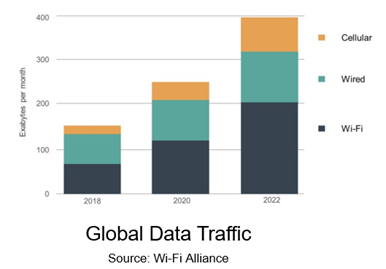

- Details
- Published on 18 March 2024
(Credit: Denys Rudyi / Alamy Stock Photo)
Industry experts predict a rapid emergence for the latest Wi-Fi version. Streaming and dense device use cases are seen as fits.
With wireless traffic far exceeding wireline data, it seems like a safe bet that the emergence of Wi-Fi 7 will take and hold the attention of enterprises and carriers looking to put the latest Wi-Fi products to work.
Buoyed by the recently launched Wi-Fi 7 Certified product certification program by the Wi-Fi Alliance, approved products will likely be embraced as part of the most compelling segment of the Internet access market this year.
“With the Wi-Fi Alliance recently announcing the opening of certification testing for Wi-Fi 7 products, don’t be surprised to see dozens of Wi-Fi 7 residential routers and broadband CPE models being deployed by operators by the end of this year,” explained Jeff Heynen, VP Broadband Access and Home Networking at Dell’Oro Group, a global market research firm. "Early gateway models, though pricey, have already been introduced to the market and will become much more widely available this spring and then well before the holiday season."
Why the rise of Wi-Fi 7?
Wi-Fi 7 products offer significantly more performance for enterprise users and can support more users in denser environments compared to Wi-Fi 6. It is pitched as a match for streaming applications and is able to handle more users per Access Point (AP), which translates into fewer devices to manage and maintain in deployments.
Wi-Fi 7 is attractive for many reasons. The first is its flexibility. The IEEE standard 802.11be works with several radio frequency bands, including 2.4GHz, 5GHz, and 6GHz. Its speed is another selling point, as it provides links at up to 40,000 M bit/sec. "When using Wi-Fi 7, the quality and resolution of video streaming are improved by 16 spatial streams and Multiple Input Multiple Output (MIMO) technology," according to Mordor Intelligence. Another feature of Wi-Fi 7, Hybrid Automatic Repeat Request (HARQ), enables multiple link adaptation.
Also of importance is that WI-Fi-7 devices are compatible with its most recent predecessor, Wi-Fi 6E.
Operators to Embrace Wi-Fi 7
There is more to Wi-Fi 7’s rapid emergence than simply technical features and advanced capabilities.
“Operators can’t wait to deploy Wi-Fi 7 products to help differentiate themselves in increasingly crowded broadband markets and to eliminate much of the confusion in the market with the coexistence of Wi-Fi 6 and Wi-Fi 6E,” explained Heynen.
While Wi-Fi 6E offers specific benefits over its Wi-Fi 6 predecessor, the latter has been implemented by entertainment and sports venue owners to best service fans in the stands who are increasingly armed with powerful mobile devices equipped with team and concessions apps. Pro sports teams are using Wi-Fi 6 to collect data from fans, which is used to provide each attendee with a more personalized experience.
Higher Performance Wi-Fi 7 Driven by Soaring Traffic
The amount of traffic being carried over Wi-Fi networks globally has roughly quadrupled in four years. In contrast, traffic over wired networks has only grown modestly during that same period, according to the Wi-Fi Alliance.

Early Wi-Fi 7 Products at Mobile World Congress
Last year saw chip, module, and device vendors, including Qualcomm, Broadcom, Intel, MediaTek, and CommScope, roll out products. Now, the Wi-Fi Alliance is forecasting more than 233 million Wi-Fi 7 devices to enter the market in 2024, growing to 2.1 billion devices by 2028.
Keysight Technologies plans to show its Wi-Fi 7 wireless connectivity test platform at the Mobile World Congress 2024 (MWC) in Barcelona later this month.
Wi-Fi 7 Certified Program to Drive Deployment
Just last month, the Wi-Fi Alliance launched the Wi-Fi 7 Certified program, which is designed to approve an interoperable device that provides a certain set of required capabilities. It is unclear if products released before certification will be compliant or adjusted to be compliant. As a resource for operators and business users (and those working from home), the alliance has created a product finder resource on its website where folks can type in a product name and maker to see if it’s certified.
The Bottom Line on Wi-Fi 7
Streaming-friendly features, frequency flexibility, and the bandwidth to address dense device environments portend to fuel the emergence of Wi-Fi 7. The Wi-Fi 7 market was valued at $875 million in the current year and is expected to reach $6.07 billion in the next five years, registering a CAGR of 47.32% over the forecast period, according to Mordor Intelligence.
The Wi-Fi 7 space is worth watching – closely - for enterprises and operators.
Related articles:

